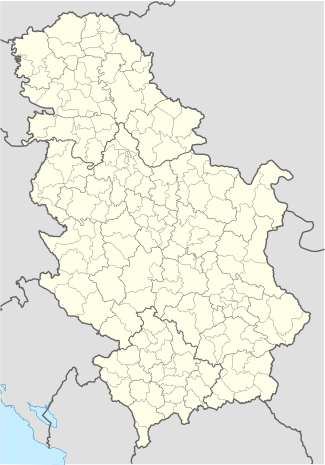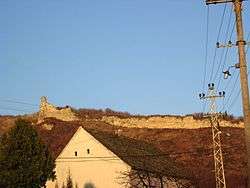Stari Slankamen
| Stari Slankamen Стари Сланкамен | |
|---|---|
| Village | |
 | |
 Stari Slankamen | |
| Coordinates: RS 45°8′20″N 20°15′16″E / 45.13889°N 20.25444°E | |
| Country | Serbia |
| Province | Vojvodina |
| District | Syrmia District |
| Municipality | Inđija |
| Time zone | CET (UTC+1) |
| • Summer (DST) | CEST (UTC+2) |
Stari Slankamen (Serbian Cyrillic: Стари Сланкамен), also known as Slankamen (Serbian Cyrillic: Сланкамен), is a village located in the Inđija municipality, in the Syrmia District of Serbia. It is situated in the Autonomous Province of Vojvodina. The population of the village numbering 674 people, of whom 485 are ethnic Serbs (2002 census).
Name
Its name means "Old Slankamen", while the name of the neighbouring village, Novi Slankamen, means "New Slankamen". The name "Slankamen" itself means "the salty stone" in Serbian and Croatian. In Hungarian the village is known as Szalánkemén or Sztari Szlankamen (formerly also: Zalánkemén), in German as Alt-Slankamen, and in Turkish as Salankamen.
History

In the 3rd century BC, the area was inhabited by Celtic Scordisci. In the first century BC, the fort was conquered by Romans and the settlement was known as Acumincum (acumen, point[1]). A Flavian fort was strategically situated for monitoring the lands beyond the Tisza river, the Legion camp cohors I Britannica equitata[2] and II Adjutrix[3] were based in the town. Jupiter Dolichenus sculptures have been found in the town.[4] Roman fortifications were excavated in the site of Dugorep.[5]
Slavs settled in the area in the 6th century. Old Slavic graves dating from the 6th and 7th century have been found in Slankamen. During the Middle Ages, Slankamen was a fortified city and was first mentioned in 1072 as Castrum Zalankemen. Arsenije I Bogdanović from Srem, the second Serb archbishop (1233–1263), after Saint Sava was born in the village Dabar near Slankamen. In 1325, according to a letter by pope John XXII to the Roman Catholic archbishop of Kalocsa, a public hospital was built in the village. In the 15th century, the town was a possession of the Serbian despots Stefan Lazarević and Đurađ Branković. From 1451, it was property of Hunyadis and from 1498 of John Corvin. In the 16th century it was a residence of Radoslav Čelnik, a duke of Srem.
In 1783, the village known as Novi Slankamen (New Slankamen) was founded near Stari Slankamen (Old Slankamen).
Historical population

- 1961: 778
- 1971: 756
- 1981: 638
- 1991: 575
Culture
The Orthodox Church dedicated to Saint Nikola was, according to the legend, founded in 1468 by Serbian despot Vuk Grgurević.
Famous people
- Radoslav Čelnik, a duke of Srem in the 16th century.
- János Kakas de Zalánkemén, a Hungarian traveller and writer in the 17th century, in 1602 published a book about his trip to Persia.
- János Szalánkeméni, a Hungarian monographist of the Catholic Church in the 16th century.
- Baron Gyula Wlassics de Zalánkemén (1852–1937), a Hungarian jurist, minister and academic.
See also
References
- ↑ Chambers's encyclopaedia: a dictionary of universal knowledge for ... Vol 7
- ↑ Roman Auxiliary Forts 27 BC-AD 378-Duncan B. Campbell
- ↑ Studies in Roman History-Ernest George Hardy
- ↑ Eastern cults in Moesia Inferior and Thracia (5th century BC-4th century AD)-Margarita Tacheva-Hitova,Margarita Tacheva
- ↑ http://old.perseus.tufts.edu/cgi-bin/ptext?doc=Perseus:text:1999.04.0006&query=id%3D%231514
- Slobodan Ćurčić, Broj stanovnika Vojvodine, Novi Sad, 1996.
External links
| Wikimedia Commons has media related to Stari Slankamen. |
Coordinates: 45°08′24″N 20°15′36″E / 45.1399°N 20.2599°E